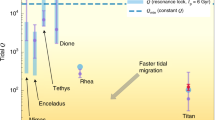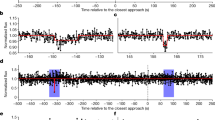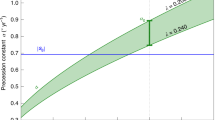Abstract
SATURN 's F ring, which lies 3,400 km beyond the edge of the main ring system, was discovered by the Pioneer 11 spacecraft1 in 1979. It is a narrow, eccentric ring which shows an unusual 'braided' appearance in several Voyager 1 images2 obtained in 1980, although it appears more regular in images from Voyager 2 obtained nine months later3. The discovery of the moons Pandora and Prometheus orbiting on either side of the ring provided a partial explanation for some of the observed features4. Recent observations of Prometheus5,6 by the Hubble Space Telescope show, surprisingly, that it is lagging behind its expected position by ∼20°. By modelling the dynamical evolution of the entire Prometheus–F ring–Pandora system, we show here that Prometheus probably encountered the core of the F ring in 1994 and that it may still be entering parts of the ring once per orbit. Collisions with objects in the F ring provide a plausible explanation for the observed lag and imply that the mass of the F ring is probably less than 25% that of Prometheus.
This is a preview of subscription content, access via your institution
Access options
Subscribe to this journal
Receive 51 print issues and online access
$199.00 per year
only $3.90 per issue
Buy this article
- Purchase on Springer Link
- Instant access to full article PDF
Prices may be subject to local taxes which are calculated during checkout
Similar content being viewed by others
References
Gehrels, T. et al. Science 207, 434–439 (1980).
Smith B. A. et al. Science 212, 163–191 (1981).
Smith, B. A. et al. Science 215, 504–537 (1982).
Kolvoord, R. A., Burns, J. A. & Showalter, M. R. Nature 345, 695–697 (1990).
Bosh, A. S. & Rivkin, A. S. IAU Circ. No. 6192 (1995).
Nicholson, P. D. et al. IAU Circ. No. 6243 (1995).
Nicholson, P. D., Hamilton, D. P., Matthews, K. & Yoder, C. F. Icarus 100, 464–484 (1992).
Murray, C. D. Phil. Trans. R. Soc. Lond. A 349, 335–344 (1994).
Murray, C. D. Bull. Am. astr. Soc. 26, 1142 (1994).
Synnott, S. P., Terrile, R. J., Jacobson, R. A. & Smith, B. A. Icarus 53, 156–158 (1983).
Borderies, N., Goldreich, P. & Tremaine, S. Icarus 53, 84–89 (1983).
Dermott, S. F. & Nicholson, P. D. Nature 319, 115–120 (1986).
Giuliatti Winter, S. M. & Murray, C. D. Bull. Am. astr. Soc. 25, 1072 (1993).
Giuliatti Winter, S. M. thesis, Univ. London (1994).
Showalter, M. R., Pollack, J. P., Ockert, M. E., Doyle, L. R. & Dalton, J. B. Icarus 100, 394–411 (1992).
Terrile, R. J. in Planetary Rings (ed. Brahic, A.) 225 (IAU Colloq. No. 75, Cepadues, Toulouse, 1984).
Thomas, P., Veverka, J. & Dermott, S. F. in Satellites (eds Burns, J. A. & Matthews, M. S.) 802–835 (Univ. Arizona Press, Tucson, 1986).
Author information
Authors and Affiliations
Rights and permissions
About this article
Cite this article
Murray, C., Giuliatti Winter, S. Periodic collisions between the moon Prometheus and Saturn's F ring. Nature 380, 139–141 (1996). https://doi.org/10.1038/380139a0
Received:
Accepted:
Issue Date:
DOI: https://doi.org/10.1038/380139a0
This article is cited by
-
How Prometheus creates structure in Saturn's F ring
Nature (2005)
-
Fingerprints in Saturn's F ring
Nature Physics (2005)
-
Analysing the New Saturnian Rings, R/2004 S1 and R/2004 S2
Earth, Moon, and Planets (2005)
Comments
By submitting a comment you agree to abide by our Terms and Community Guidelines. If you find something abusive or that does not comply with our terms or guidelines please flag it as inappropriate.



